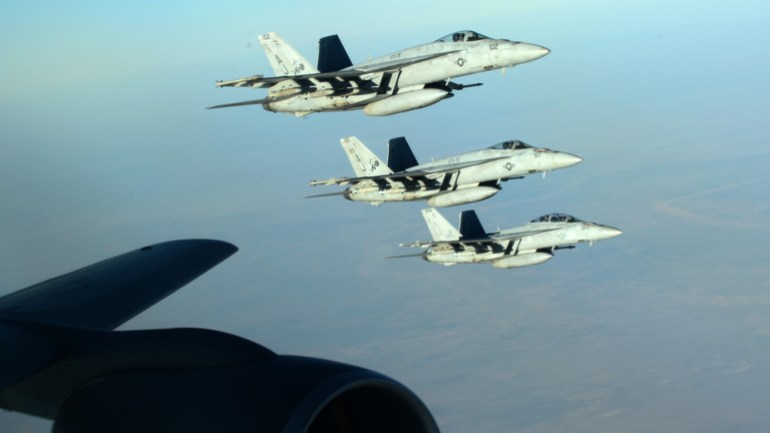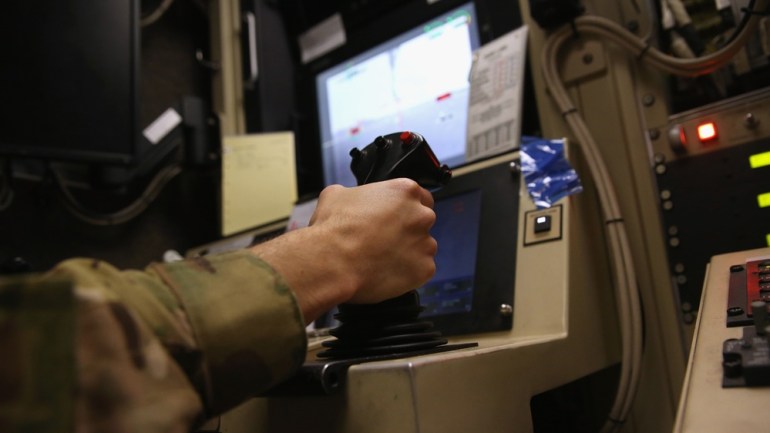US army data on civilian harm in war against ISIL questioned
Withholding of more precise data raises eyebrows as rights groups remain sceptical of geographic coordinates in densely-populated areas.

Erbil, Kurdish region of northern Iraq – Rights groups and charities have raised questions over the United States military coordinates of civilian harm in Iraq and Syria released last week by the United Kingdom-based watchdog, Airwars.
In a data-sharing agreement hailed by the non-profit as a “groundbreaking decision by the US-led Coalition”, Airwars made public the geographic coordinates of 341 confirmed incidents of civilian harm and roughly 1,400 civilian deaths since the war against ISIL (ISIS) started six years ago.
Keep reading
list of 3 itemsThere can be no ‘going back to normal’ in Iraq
Is ISIL resurging amid the coronavirus pandemic?
During the campaign to retake the ISIL-occupied territories in Iraq and Syria, the battles for Mosul and Raqqa marked the height of destruction and civilian casualties.
Airwars estimated that more than 13,000 non-combatants were confirmed killed in the campaign due to the coalition’s actions since 2014. The coalition puts that number at just 1,410.
Once prominent commercial and cultural centres in the region, the two cities were razed to the ground by coalition air raids in the name of liberation. According to the United Nations, much of the old city of Mosul and 70 percent of Raqqa were destroyed.

The data provided by Airwars states that 70 of the 341 credible incidents have been pinpointed to an accuracy of one square metre (10.8 square feet), leaving little margin for error. The remaining 271, however, are accurate to within 100sq m (1,076sq ft).
“The coalition has the one metre squared coordinates of all events it has deemed credible, though more recently has chosen to withhold publicly that more precise data. We don’t know why and it’s for OIR to explain their reasoning,” Airwars director Chris Woods told Al Jazeera.
OIR refers to the Combined Joint Task Forces – Operation Inherent Resolve, as the US-led coalition against ISIL is officially known.
In an air campaign that has been described by the British Foreign Office as “the most precise in history of warfare”, the withholding of more precise data has raised eyebrows.
“Either the coalition doesn’t have the specific coordinates of the buildings it bombs, which would be very concerning, or they do have them and we presume they do, so why are they not providing them?” asked Amnesty International’s senior crisis adviser, Donatella Rovera.
“It has to do with liability, with not wanting to take responsibility.”
Devil in the details: Activists
In populated areas such as Raqqa and Mosul, 100 metres (328 feet) “could be the distance between a legitimate military target and a school or an apartment building,” said Iain Overton of the London-based explosive violence monitoring charity, Action on Armed Violence (AOAV).
While Amnesty’s Rovera does not dismiss the Airwars findings, she argues that “unless the data is accurate, you won’t be able to do much with it at all”.
Over the years, rights groups and watchdogs have worked on the ground and provided the coalition with the precise coordinates of their air raids.
The only known ground investigation carried out by the coalition followed the al-Jadida Mosul attack of March 2017, which killed more than 140 civilians.
“To determine whether a strike is lawful, you need to have the precise location to analyse what happened to that strike,” said Rovera. “One hundred metre radius coordinates are not useful.”
Airwars director Woods disagrees. “Even locational data to within a 100 metre box has significant value, allowing affected families to determine whether loved ones were or weren’t likely harmed in a particular event, in a particular neighbourhood.”
However, even “accuracy” could be an ambiguous term, particularly when a war takes place in dense neighbourhoods, and as was the case with ISIL, the enemy hiding among the civilian population.
AOAV’s data on explosive weapons over a decade globally has shown that “when explosive weapons with wide area effects are used in populated areas, over 90 percent of those reported in English-language media as killed or injured have repeatedly and routinely been civilians,” said Overton. “No amount of ‘accuracy’ alters that repeated truth.”

Closure through compensation?
Mosul resident Ali al-Baroodi knows this all too well. The battle to retake Mosul had been raging for just over a month when he was hurled across his bedroom by the force of an explosion.
Nearby, an air attack had targeted ISIL vehicles as they moved from one neighbourhood to another.
The attack lasted 16 hours, wounding al-Baroodi’s brother and damaging their home.
According to AOAV, 75 percent of people reported killed or injured by air raids over Mosul were civilians.
In addition to their loved ones, hundreds of thousands lost their livelihoods and homes. So far, only six Iraqis and one Syrian have received ex gratia (or condolence) payments – a way for the US to not have to accept liability for property damage, injuries or deaths.
According to Airwars, the release of the data can “help to prise open the door on possible restitution for civilian harm from US and coalition actions in Iraq and Syria”.
“It’s never enough,” Al Baroodi said over the telephone from his home in Mosul.
“Paying without confessing that the excessive force wasn’t justifiable – to use heavy artillery, to shell an ancient city that was heavily dense with people.”
But even those who hoped for monetary support after losing homes and relatives have been denied help by the coalition.
In January, Human Rights Watch recounted the story of Shadia, who lost her loved ones when a weeks-long military campaign near Raqqa destroyed a boarding school and other buildings.
The US concluded that 40 civilians were killed in a raid, including Shadia’s relatives.
The US Defense Department’s response to a request for ex gratia payments for Shadia’s family was as follows: “Prior to conducting the air attack, CJTF-OIR took significant precautions to assess the risk of civilian casualties and other collateral damage, and did not assess the presence of civilians families. Although the result was tragic, US forces complied with the law of war.”
Meanwhile in Iraq and in Syria, civilians continue to rebuild their lives disrupted by the war against ISIL, haunted by its memories.
“I can pay a million dollars, just let them take the noise and memory,” said al-Baroodi from Mosul. “The dust and the blood and how my nephews and nieces crowded over their dad.”